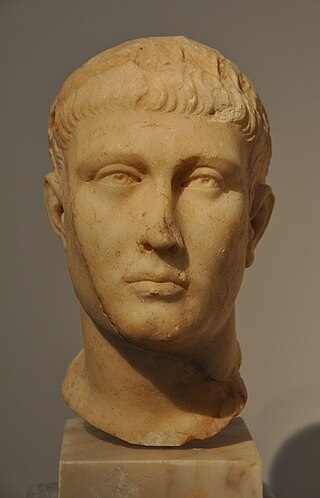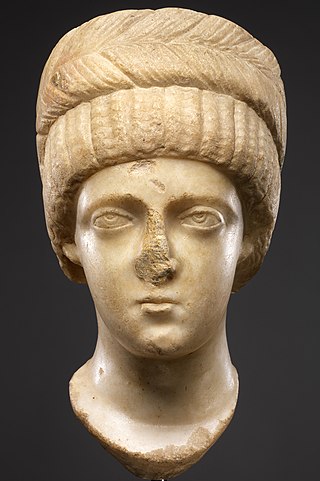Related Research Articles

Theodosius I, also called Theodosius the Great, was a Roman emperor from 379 to 395. He won two civil wars, and was instrumental in establishing the Nicene Creed as the orthodox doctrine for Nicene Christianity. Theodosius was the last emperor to rule the entire Roman Empire before its administration was permanently split between the Western Roman Empire and the Eastern Roman Empire. He achieved a settlement to the Gothic War (376–382), although the Goths remained in control of Roman territory as subject allies.

Marcian was Roman emperor of the East from 450 to 457. Very little of his life before becoming emperor is known, other than that he was a domesticus who served under the commanders Ardabur and his son Aspar for fifteen years. After the death of Emperor Theodosius II on 28 July 450, Marcian was made a candidate for the throne by Aspar, who held much influence because of his military power. After a month of negotiations Pulcheria, Theodosius' sister, agreed to marry Marcian. Zeno, a military leader whose influence was similar to Aspar's, may have been involved in these negotiations, as he was given the high-ranking court title of patrician upon Marcian's accession. Marcian was elected and inaugurated on 25 August 450.

Gratian was emperor of the Western Roman Empire from 367 to 383. The eldest son of Valentinian I, Gratian was raised to the rank of Augustus as a child and inherited the West after his father's death in 375. He nominally shared the government with his infant half-brother Valentinian II, who was also acclaimed emperor in Pannonia on Valentinian's death. The East was ruled by his uncle Valens, who was later succeeded by Theodosius I.

Aelia Eudocia Augusta, also called Saint Eudocia, was an Eastern Roman empress by marriage to Emperor Theodosius II, and a prominent Greek historical figure in understanding the rise of Christianity during the beginning of the Byzantine Empire. Eudocia lived in a world where Greek paganism and Christianity existed side by side. Although Eudocia's work has been mostly ignored by modern scholars, her poetry and literary work are great examples of how her Christian faith and Greek heritage and upbringing were intertwined, exemplifying a legacy that the Roman Empire left behind on the Christian world.
Count Theodosius or Theodosius the Elder, was a senior military officer serving Valentinian I and the Western Roman Empire during Late Antiquity. Under his command the Roman army defeated numerous threats, incursions, and usurpations. Theodosius was patriarch of the imperial Theodosian dynasty and father of the emperor Theodosius the Great.

Eugenius was a Western Roman emperor from 392 to 394, unrecognized by the Eastern Roman emperor Theodosius I. While Christian himself, Eugenius capitalized on the discontent in the West caused by Theodosius' religious policies targeting pagans. He renovated the pagan Temple of Venus and Roma and restored the Altar of Victory after continued petitions from the Roman Senate. Eugenius replaced Theodosius' administrators with men loyal to him. This included pagans, reviving the pagan cause. His army fought the army of Theodosius at the Battle of the Frigidus, where he was captured and executed.

Aelia Pulcheria was an Eastern Roman empress who advised her brother, the emperor Theodosius II, during his minority and then became wife to emperor Marcian from November 450 to her death in 453.

Aelia Eudoxia was a Roman empress consort by marriage to the Roman emperor Arcadius. The marriage was the source of some controversy, as it was arranged by Eutropius, one of the eunuch court officials, who was attempting to expand his influence. As Empress, she came into conflict with John Chrysostom, the Patriarch of Constantinople, who was popular among the common folk for his denunciations of imperial and clerical excess. She had five children, four of whom survived to adulthood, including her only son and future emperor Theodosius II, but she had two additional pregnancies that ended in either miscarriages or stillbirths and she died as a result of the latter one.

Victor was a Western Roman emperor from either 383/384 or 387 to August 388. He was the son of the magister militum Magnus Maximus, who later became a usurper of the Western Roman Empire, in opposition to Gratian. Maximus rose up in 383, and was recognized as the legitimate emperor in the west by Theodosius I. Victor was elevated to augustus of the Western Roman Empire in either 383/384 or mid-387, making him co-emperor with his father. Maximus invaded Italy in 387, to depose Valentinian II, the brother and successor of the late Gratian. Because of Maximus' invasion, Theodosius invaded the Western Empire in 388. Theodosius defeated Maximus in two battles in Pannonia, before crushing his army at Aquilea, and capturing Maximus. Maximus was executed on 28 August 388. His death was followed quickly by that of Victor, who was executed in Trier by the Frankish general Arbogast.

The Theodosian dynasty was a Roman imperial family that produced five Roman emperors during Late Antiquity, reigning over the Roman Empire from 379 to 457. The dynasty's patriarch was Theodosius the Elder, whose son Theodosius the Great was made Roman emperor in 379. Theodosius's two sons both became emperors, while his daughter married Constantius III, producing a daughter that became an empress and a son also became emperor. The dynasty of Theodosius married into, and reigned concurrently with, the ruling Valentinianic dynasty, and was succeeded by the Leonid dynasty with the accession of Leo the Great.

Serena was a member of the Theodosian dynasty as the niece of the emperor Theodosius I, as well as the wife of the military commander Stilicho.

Aelia Flavia Flaccilla was a Roman empress and first wife of the Roman Emperor Theodosius I. She was of Hispanian Roman descent. During her marriage to Theodosius, she gave birth to two sons – future Emperors Arcadius and Honorius – and a daughter, Aelia Pulcheria.
Justina was a Roman empress. She was initially the wife of the rebel emperor Magnentius and was then married to Valentinian I, with whom she had four children, including the emperor Valentinian II and the empress Galla.
Arbogast or Arbogastes was a Roman army officer of Frankish origin. He won distinction in the service of the emperor Gratian, and was subsequently entrusted by Theodosius I with the guardianship of the underage Valentinian II. The death of Valentinian in mysterious circumstances, and the rise of the controversial Eugenius, led to a civil war in which Arbogast perished.
Domnica was a Roman empress as the wife of the emperor Valens, who ruled the East from 364 to 378. After the death of her husband at the Battle of Adrianople, she ruled as de facto regent and defended Constantinople against the attacking Goths until his successor Theodosius I arrived.
Galla was a Roman empress as the second wife of Theodosius I. She was the daughter of Valentinian I and his second wife Justina.
Flavius Merobaudes was a Roman army officer of Frankish origin. He was appointed magister peditum around 375, and consul twice in 377 and 383. Ancient sources record that he was put to death that year for his support of the imperial usurper Magnus Maximus, but an inscription records that he became consul a third time in 388.
Tiberius was the second son of Byzantine Emperor Maurice and his wife Constantina. His father intended him to inherit Italy and the western islands, centered in Rome; however, this did not come to fruition as his father was overthrown by the new Emperor Phocas, who had him and his father executed, along with his younger brothers, in the Harbor of Eutropius, Chalcedon.

Eucherius was the son of Stilicho, the magister militum of the Western Roman Empire, and Serena, a Roman noblewoman who was the niece of Eastern Roman Emperor Theodosius I. He was born in c. 388 in Rome, Italy. Despite being the son of the magister militum, Eucherius did not rise farther than the modest rank of tribune of the notaries. Stilicho was accused by his political opponents of plotting to install Eucherius as a third emperor in Illyricum, and as a result of this Stilicho was arrested and executed on 22 August 408, and Eucherius soon after.
John Robert Martindale is a British historian specializing in the later Roman and Byzantine empires. Martindale's major publications are his magnum opus, the Prosopography of the Later Roman Empire, begun by A. H. M. Jones and published between 1971 and 1992, and the first part of Prosopography of the Byzantine Empire, which was published in 2001.
References
- ↑ Holum 1982, pp. 21–22.
- ↑ Hebblewhite 2020, p. 26.
- 1 2 Holum 1982, p. 22.
- ↑ Jones, Martindale & Morris, p. 756.